Meet The SWLG Steering Team
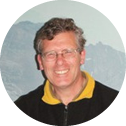
Tim Ambrose (Treasurer)
I have been Treasurer of the SWLG since 1988, when I was a working Chartered Accountant. I was brought up in Surrey, but after several walking holidays in Scotland when I was a student, I decided to come and live here in 1975, and have never regretted this. I have climbed most of the Munros and visited many of the islands, the best ones many times, with some dull, and some difficult ones still to do. Lucky enough to get early retirement some years ago, I did a Geology degree at Aberdeen University to try to help me understand better the rocks and history of what I was walking over in Scotland, but it mainly confirmed how interesting and varied Scotland is, and how much more there is to learn and discover.
I love the wildness you can sometimes find in Scotland, and hate the desecration of the mountains by dams, roads, bulldozed tracks and their scars, fences, wind turbines, pylons, ski-lifts, sharp-edged forestry, and too many sheep and deer preventing regeneration of native trees and plants. Keep roads and quadbikes to the valleys and periphery, bring back highland ponies for transport in the mountains, and let the beaver and the wolf roam free.
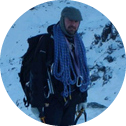
Grant Cornwallis (Membership Secretary)
About 20 years ago, I joined the SWLG and was enthused by the open, friendly and democratic nature of the AGMs. In the early 1990s, with Lionel as Co-ordinator, we had fine meetings like the one where that fellow Ian Wilson (who just happened to own the mineral rights to lots of potential superquarry sites) helpfully showed us why large, exploitative developments have to be opposed. Had such superquarries been approved 10 years ago, it would be much harder to resist the current assault from the profit seekers and their bogus green revolution of wind turbines for all. Cries of “it’s too late now, the wild lands have been industrialised already” are mercifully premature, though the threats are legion and have feet of concrete!
The SWLG inspired my group of young hill-goers then, so I believe we can help develop awareness of, and rouse opposition to, the threats facing Scotland’s wild land now. If we allow the exploiters and despoilers (the very same people who brought us Credit Crunchies for breakfast, mind) to proceed unchecked, then future generations will curse our stupidity, whilst they pay the full price for the greed of our times. Some legacy.
Oh, and I’m a piper and traditional singer, who enjoys the rock-climbing and bothying life, which I preferred to attending university.
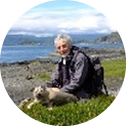
James Fenton (Editor Wild Land News)
James spent many of his formative years living in Wester Ross, during which period he perhaps first gained a keenness for wild places. He graduated with a degree in botany and subsequently worked for the British Antarctic Survey for five years where he undertook research on Antarctic peat growth, gaining a PhD in the process. In 1985 he set up as one of the first ecological consultants in Scotland. He also launched SCENES: Scottish Environment News to further communication amongst the then warring factions, and was a founder-member of the Save the Cairngorms Campaign during the Lurchers Gully (2) planning application.
In 1991 James became the National Trust for Scotland’s first Ecologist, carrying out ecological surveys, providing ecological advice across the whole NTS landholding, and contributing to NTS policies on woodland and grazing. In 2005 he left NTS and joined SNH to work on landscape policy; here he coordinated SNH’s work in identifying the special qualities of all of Scotland’s 40 National Scenic Areas and both National Parks.
James has always had an interest in wild places. He has written the ‘Field Guide to Ice’ and, more recently, a book on peat bogs, 'An Illustrated Guide to Peat' (both available from NHBS.com). He is also an elected board member of the National Trust for Scotland.
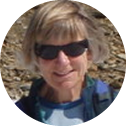
Beryl Leatherland (Former Convenor)
We came up to Scotland when my husband got his first job here, decades ago now! I was introduced to the Scottish hills by a work colleague and immediately felt at home – their scale [especially compared with the Brecon Beacons which I roamed as a youngster], the beauty of the landscape, the amazing ecology [I’m a biologist so tend to notice these aspects], the mountaineering culture and history and the space and freedom to walk, climb and camp wherever I liked.
Gradually over the years I became involved in exploring the hills, improved my skills, completed the Munros, explored wintry corries and ridges and did many classic Winter climbs – just the easy ones. The best time in the Scottish hills is undoubtedly the winter when Nature and the elements create amazing snow and ice formations; flutings on natural features, icy sculptures around burns and waterfalls, and huge curling cornices on corrie rims. There is also reassuring satisfaction in being able to make oneself comfortable in adverse conditions. This gives way to the Spring changes in the snow pack and finally the temptations of more remote camps in high corries and long glens, watered by clear snow melt, and observing the emergence of new life.
I joined SWLG in 1983, motivated by the threats to the landscape at that time; new ski developments in the Cairngorms and quarries. These seem very tame now compared with the industrial proliferation of onshore wind developments and some other renewables in what many of us consider to be inappropriate locations, and until recently, totally unregulated track construction, often built to a poor standard, on estates – the latter is an ongoing campaign for us of course, despite the progress made in the last couple of years.
I was a volunteer with MCofS for around 12 years but when my last term of office came to an end, I at last became more active with SWLG and joined the Steering Group in 2012; a group of dedicated enthusiasts, who try to do so much with such limited resources in terms of time and manpower.
Threats to wild land continue; the SNH Wild Land Map is essential and welcomed but has come too late and at great cost to the area it could have potentially covered. The attrition of wild land is worth resisting, so we must defend to the utmost what we have left, as well as aspiring to see it enhanced. We need to continue to collaborate with like minded organisations and pool our efforts in making our voices heard in defence of our unique landscapes and biodiversity.
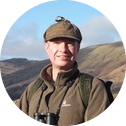
Peter Ewing (Convenor)
I am an NHS general practitioner working in rural Perthshire. Like most SWLG members I care about wild land because I've been exposed to it: I'm a keen hillwalker currently pursuing the mountain leader qualification, I enjoy wild camping trips in my Canadian canoe, and I'm a recreational deer stalker with the basic deer management qualification.
The long solo trip in remote wild country is an achingly beautiful experience: it gives a sense of self-reliance and connectedness that is unknown and incomprehensible to the non-outdoorsman. And that is the problem: the raw need for unbroken country is only familiar to those who've spent time 'out there', and so our wild land is not widely recognised as the priceless resource it is.
The ongoing degradation of wild land through artificially high deer densities, wind-farms, bulldozed hill tracks, blanket sitka afforestation and inappropriate development horrifies me. But it does not have to be this way.
I may be a doctor but I don't actually heal people – nature does that. Doctors just make the conditions for natural healing to occur. So we sew together the edges of a gaping wound, set fractured bones into their correct position and kill off invasive bacteria with antibiotics. We treat Clostridium difficile infection by putting back the normal gut organisms that should be there. And sometimes we stop the growth of abnormal cells that would blindly and recklessly grow until they killed both themselves and their host.
So it is with wild land. We can restore natural processes by reintroducing native species that should be there like the beaver and lynx. We can regenerate our native woodlands by controlling unnaturally high deer numbers to allow natural forest regeneration and planting trees when there is no seed source nearby. We can remove non-native species like sitka spruce. And we can campaign against, and ultimately check, the spreading cancer of inappropriate development.
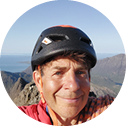
Mark Aitken
Our wild land is key to Scotland’s identity, and provides crucial environmental, economic, health and societal benefits. Protecting wild land is also critical to help mitigate the climate and biodiversity crises. SWLG has key objectives to increase the conservation of wild land.
Following my retirement from SEPA in 2022, I’m very pleased to have more time to help implement the SWLG objectives. My experience of environmental issues, the land sector, partnership working, management, communications, national policies, and implementing strategies and plans, will hopefully be helpful.
Prior to retirement, my work over the last 38 years focussed on the sustainable use of land:
18 years as SEPA’s Principal Policy Officer on Land, and Land Policy Unit Manager.
12 years with Scotland's Rural College as Lecturer in Environmental Sciences, and then Team Leader and Principal Consultant in Land Management.
8 years as Soil Science Adviser with the Ministry of Agriculture.
I love wild places and much of my free time is spent there. For 40 years, I’ve very regularly enjoyed hillwalking, mountaineering, winter and rock climbing, expeditions, coastal exploration and wildlife watching. I’ve completed the Munros twice. I want to do my very best to help protect our wild land, and to encourage re-wilding, and to help Scotland’s response to the climate and biodiversity crises.
I’m currently also an elected trustee for the John Muir Trust and a member of Scottish Wildlife Trust’s Conservation Committee.
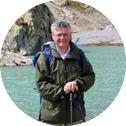
David Roper
Born in England I moved to Scotland in 1980, arriving with the young sassenach’s naivety intent on starting a new job on 2nd January. Everyone knows it’s a bank holiday, except me. Scotland immediately enthralled me, particularly the Cairngorms. Forty plus years later I’m still here, roots more deeply sunk than a Scots pine clinging to an outcrop.
With children (a loon and a quine) grown up and proper retirement looming, I (was told I) needed something the keep me off the streets. Being an SWLG member for some years and having helped Tim (or perhaps hindered, sometime it’s hard to tell) in converting to a SCIO, I fell for the age old trick of being asked at the 2022 AGM if I’d ever thought of becoming a trustee. So here I am.
By way of qualifications for the role, I worked in the oil industry, set up and ran a software company from the mid-eighties before selling it in 2000 and returning to University to take a law degree, which somewhat inadvertently led to my qualifying as a solicitor (don’t ask, it’s a long story… ). I know just enough about business and law to be both useful and truly dangerous at the same time. I’m lucky enough to live in Strathdon, on the very edge of the Cairngorms National Park. There are Corbetts all around and I’ve fought the occasional battle to beat off wind farms. I have two dogs that need regular walks, volunteer with the JMT (mostly Glen Tanar) and am also the secretary of the Silver Circle, a small charity supporting elderly and isolated members of the local community.
Bill Stephens
Concerned about the ever increasing loss of our wildscapes, I joined the Scottish Wild Land Group and am a long time life member of the John Muir Trust. I’m also a life member of the Friends of the Lake District, where we lived until 2017, moving back to the Tweed Valley for family reasons.
Learning to canoe here sixty years ago, I still get out on the river and sea as much as possible, including expeditions to Greenland and Arctic Norway. In winter I enjoy exploring the Scottish hills and the Alpine mountains on skis with occasional trips further afield, including Iceland and North Africa.
A retired Member of the Royal Town Planning Institute, Member of the Institution of Civil Engineers, Chartered Environmentalist and Chartered Engineer, I worked for a period in local government, latterly on urban regeneration that included project managing the reclamation and redevelopment of the Workington and Barrow in Furness Iron and Steel works sites. Not wanting to move away from the Lake District, I established an environmental planning and engineering consultancy in Kendal and bought a small rundown Westmorland farm.
We spent many years renovating buildings, restoring dry stone walls, creating a small tarn habitat and planting 12 hectares of mainly oak, birch, alder and willow, now well established woodland. Shortly after the trees started to grow, the new owner of adjoining land cleared a large area of trees, scrub vegetation and rock outcrops for stabling horses without planning permission but the National Park Authority proved ineffective in stopping this. Since then I’ve done what I can to campaign against inappropriate development.
In recent years this has included the ‘Cairngorm Mountain’ adventure theme park, the Cononish Gold Mine, also in a National Park, the Shetland, Sutherland and North Uist ‘spaceports’ adversely affecting some of our wildest land and seascapes, the Coul Links golf course and hotel development encroaching on internationally important habitats and long distance large calibre rifle target shooting ranges covering large areas of the Southern Uplands including parts of the UK watershed ‘ribbon of wildness’. Together with objecting to various wind and hydro power projects, including the Coire Glas pumped storage scheme, I seem to be busier than ever and now have 50 years of planning practice... and counting.
Although trying to do what I can to help protect our wildscapes from inappropriate development, we are losing the battle, not helped by the fragmented and uncoordinated response from environmental groups, a continual frustration.
